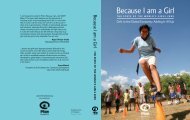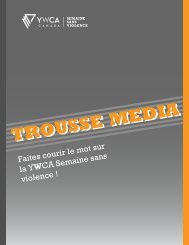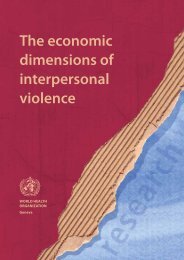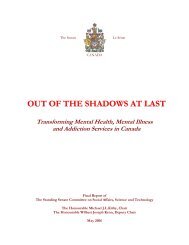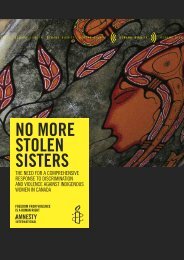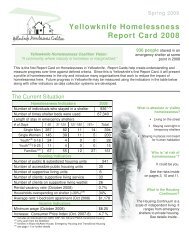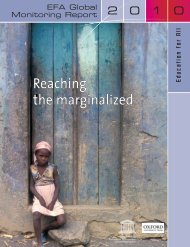Gender Report Card on the International Criminal ... - YWCA Canada
Gender Report Card on the International Criminal ... - YWCA Canada
Gender Report Card on the International Criminal ... - YWCA Canada
Create successful ePaper yourself
Turn your PDF publications into a flip-book with our unique Google optimized e-Paper software.
Structures & Instituti<strong>on</strong>al Development Structures<br />
Since 2006, <strong>the</strong> number of victims assisted and represented by <strong>the</strong> OPCV has increased<br />
from 85 victims in 2006 to 2,119 in 2011. 163 Of <strong>the</strong> total number of victims assisted by<br />
<strong>the</strong> OPCV as of October 2011, 83% are victims in relati<strong>on</strong> to <strong>the</strong> CAR (1,011) and DRC (748)<br />
Situati<strong>on</strong>s. 164 The majority of victims represented by <strong>the</strong> OPCV in 2010 were also from<br />
CAR (1,051 or 84%).<br />
During 2011, <strong>the</strong> number of victims represented in <strong>the</strong> DRC Situati<strong>on</strong> significantly<br />
increased from 63 in 2010 to 748 in 2011 largely due to <strong>the</strong> opening of a third DRC case<br />
(The Prosecutor v. Callixte Mbarushimana). 165 The number of victims represented by<br />
<strong>the</strong> OPCV in relati<strong>on</strong> to <strong>the</strong> Situati<strong>on</strong>s in Darfur (21) and Uganda (117) did not change<br />
or experienced very small changes when compared to 2010. 166 Finally, <strong>the</strong> number of<br />
victims represented by <strong>the</strong> OPCV in <strong>the</strong> Kenya Situati<strong>on</strong> increased from <strong>on</strong>e victim in<br />
2010 to 222 victims in October 2011.<br />
Out of <strong>the</strong> 2,119 victims assisted by <strong>the</strong> OPCV, 774 are female (36.5%) and 1,345 are male<br />
(63.5%). In 2010, female victims assisted by <strong>the</strong> OPCV were 479, comprising 38% of <strong>the</strong><br />
total. Male victims are <strong>the</strong> majority of those being assisted and represented by <strong>the</strong> OPCV<br />
in every Situati<strong>on</strong> in which <strong>the</strong> Office is assisting victims. The number of female victims<br />
per Situati<strong>on</strong> ranges from 14% of victims assisted by <strong>the</strong> OPCV in relati<strong>on</strong> to <strong>the</strong> Situati<strong>on</strong><br />
in Darfur to 42% in <strong>the</strong> CAR Situati<strong>on</strong>. Female victims are 30% of <strong>the</strong> total number of<br />
victims being assisted and represented by <strong>the</strong> OPCV in <strong>the</strong> DRC. In Uganda 32% and Kenya<br />
36% of those represented and assisted by <strong>the</strong> Office are female. In 2010, 44% of <strong>the</strong> DRC<br />
victims being assisted by <strong>the</strong> OPCV were women. In CAR this figure was 39%, in Uganda<br />
32%, in Sudan 14% and in Kenya 0%. 167 These figures dem<strong>on</strong>strate an overall increase<br />
in <strong>the</strong> actual number of victims and women victims being assisted and represented<br />
by <strong>the</strong> OPCV, although <strong>the</strong>re is a proporti<strong>on</strong>al decrease in <strong>the</strong> female statistics relative<br />
to <strong>the</strong> overall number of victims assisted by <strong>the</strong> Office. This is largely explained by <strong>the</strong><br />
significant shift in <strong>the</strong> proporti<strong>on</strong> of female victims assisted by <strong>the</strong> Office in <strong>the</strong> DRC<br />
Situati<strong>on</strong> from 44% in 2010 to 30% in 2011. The proporti<strong>on</strong> of female and male victims in<br />
Uganda and Sudan have remained <strong>the</strong> same, with significant increases in <strong>the</strong> number of<br />
female victims assisted or represented by <strong>the</strong> OPCV in Kenya and CAR.<br />
163 Figures as of 14 October 2011. Email communicati<strong>on</strong>s with <strong>the</strong> Office of Public Counsel for Victims, 23 August<br />
2011 and 14 October 2011.<br />
164 Ibidem.<br />
165 According to data provided by <strong>the</strong> OPCV via email communicati<strong>on</strong> <strong>on</strong> 23 August 2011, out of <strong>the</strong> total number<br />
of 873 victims represented in <strong>the</strong> DRC Situati<strong>on</strong>, 764 (87.5%) were in relati<strong>on</strong> to The Prosecutor v. Callixte<br />
Mbarushimana. Please note that <strong>the</strong> difference in <strong>the</strong> total number of victims represented in <strong>the</strong> DRC Situati<strong>on</strong><br />
as of 23 August 2011 (873) and as of 14 October 2011 (748) is due to new Legal Representatives being selected<br />
by <strong>the</strong> victims. Email communicati<strong>on</strong> with <strong>the</strong> Office of Public Counsel for Victims, 24 October 2011.<br />
166 In 2010, <strong>the</strong> OPCV assisted and represented 21 victims in relati<strong>on</strong> to <strong>the</strong> Darfur Situati<strong>on</strong> and 116 victims in<br />
relati<strong>on</strong> to <strong>the</strong> Uganda Situati<strong>on</strong>.<br />
167 Please note that 2010 figures regarding Kenya are <strong>on</strong> <strong>on</strong>e victim <strong>on</strong>ly (male). See <str<strong>on</strong>g>Gender</str<strong>on</strong>g> <str<strong>on</strong>g>Report</str<strong>on</strong>g> <str<strong>on</strong>g>Card</str<strong>on</strong>g> <strong>on</strong> <strong>the</strong><br />
Internati<strong>on</strong>al <strong>Criminal</strong> Court 2010, p 32-35.<br />
38






